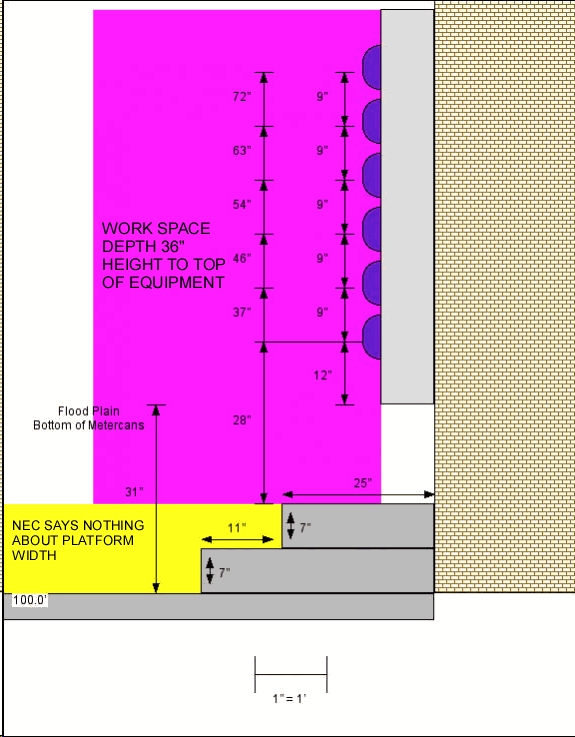- Location
- Massachusetts
George I see it your way.
Landscaping and the house keeping pad are violations, not sure about the sloped grade.So you can't have landscaping per 110.26? A sloped grade? A housekeeping pad?
They have a breaker beside every meter.
Jon: so the guys who declined to add verbiage to make it code and wrote specifically on the topic specifically stating it is acceptable are misinterpreting something here? What exact language forbids the installation?
I'm not saying it's the classiest setup, but I am still not seeing the other side here. Quote me the text that forbids the install.
Geez, are we going to have to call a special, in person, meeting of the Forum Northern Chapter over this? (its been a while, we should get together with the crew).Jon: so the guys who declined to add verbiage to make it code and wrote specifically on the topic specifically stating it is acceptable are misinterpreting something here? What exact language forbids the installation?
I'm not saying it's the classiest setup, but I am still not seeing the other side here. Quote me the text that forbids the install.
I take the OP depiction and poll to be asking solely about NEC compliance... and you guys keep coloring it with safety issues outside the scope of the NEC.George,
I note your graphic mentions flood plain and as you know, I'm originally from S. Florida. This was very common to have steps up to a platform in order to get the service equipment to a level that would comply with FEMA flood requirements. Sometimes just a couple of steps as in your graphic, others might be an entire stair case, depending on the flood elevation. But always at the top there had to be a platform that complied with 110.26. Of course this then required a compliant hand rail and platform railing when you got above a certain number of risers (a building code issue). Up until about the early 90's the meter and main disco were ignored for flood purposes, so this was not an issue.
So to answer your question, no it is not compliant.

You don't have the required work space in front of the equipment. The platform interferes with with the required workspace depth.
.....Meanwhile back at the ranch the guy tasked with drawing this is redrawing this a bit different, which should add some more fuel to the debate here. Stay tuned.
Wait a minute here, hold on......You promise some exciting new details, and this is what you come up with?Thanks for saving me the next step, Smart. There are no obstructions in the purple zone.
I agree with that.
I take the OP depiction and poll to be asking solely about NEC compliance... and you guys keep coloring it with safety issues outside the scope of the NEC.

You can stretch the boundaries of compliance to all the indirect requirements you want... but you can't make the actual requirement say something it does not.This is the icing on the cake -- you really think it is safe to examine this equipment -- Go ahead & fight about the wording -- I think I would lose in court if there was a mishap and someone lost there balance fell back and cracked their head. Being realistic has its advantages there is no reason a contractor couldn't extend the portion of step out far enough to have a decent working surface and still comply wtih steps to get above flood plain --- Non Compliant -- Look at 90.1(A) and (C) that is solely about code compliance which does factor safety in the installation( most important value IMO) and not intended as a design specification(which takes us back to the wording).
Thanks for saving me the next step, Smart. There are no obstructions in the purple zone.
Bill, I was addressing Texie.
Jon, that would be a little complicated, as the ranking member of the Forum NOCO Chapter is the inspector of the installation, and he's about 95% on board as I am, I believe.
...you really think it is safe to examine this equipment ...


